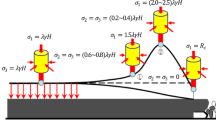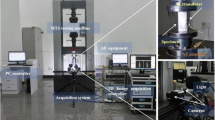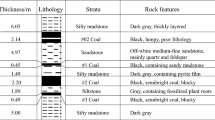Abstract
In situ stress testing can improve the safety and efficiency of coal mining. Identifying the Kaiser effect point is vital for in situ stress calculations; however, the in situ stress calculation is limited by the rock sampling angle. Here, the Kaiser effect point identification theory is established and applied to the Xuyong Coal Mine. Uniaxial compression and acoustic emission experiments were carried out on sandstone with 6 sampling directions. Furthermore, COMSOL simulation is applied to study the in situ stress distribution in the coal mine to verify the calculation accuracy. The results are as follows. 1) The failure mode of non-bedded and vertical-bedded rocks is primarily tensile shear failure with obvious brittleness in mechanical and acoustic emission characteristics. Shear slip along the bedding plane is the primary failure mode of inclined-bedded rock. Additional take-off points exist in the AE count curve. 2) The Kaiser point identification method based on the variation of AE count curve parameters Δti and τi can effectively calculate the in situ stress. According to the numerical value of Kaiser point and sampling direction, the in situ stress of the conveyor roadway in the Xuyong Coal Mine was calculated as σ1 = 22.81 MPa, σ2 = 10.87 MPa and σ3 = 6.14 MPa. 3) By the COMSOL simulation study, it was found that a stress concentration zone of 16.13 MPa exists near the two sides roadway. Compared with the Kaiser effect method, the deviation rates of the three-direction principal stress calculated by COMSOL were all less than 5%. This verifies that the in situ stress calculation by Kaiser effect in this study can be applied to the Xuyong Coal Mine.
Similar content being viewed by others
References
Alkan H, Cinar Y, Pusch G (2007). Rock salt dilatancy boundary from combined acoustic emission and triaxial compression tests. Int J Rock Mech Min Sci, 44(1): 108–119
Bai X, Zhang D M, Wang H, Li S J, Rao Z (2018). A novel in situ stress measurement method based on acoustic emission Kaiser effect: a theoretical and experimental study. R Soc Open Sci, 5(10): 181263
Basirat F, Tsang C F, Tatomir A, Guglielmi Y, Dobson P, Cook P, Dessirier B, Juhlin C, Niemi A (2021). Hydraulic modeling of induced and propagated fractures: analysis of flow and pressure data from hydromechanical experiments in the COSC-1 deep borehole in crystalline rock near Åre, Sweden. Water Resour Res, 57(11): e2020WR029484
Cao Z Z, Wang Y, Lin H X, Sun Q, Wu X G, Yang X S (2022). Hydraulic fracturing mechanism of rock mass under stress-damage-seepage coupling effect. Geofluids, 2022: 5241708
Chen Y L, Meng Q B, Li Y C, Pu H, Zhang K (2020). Assessment of appropriate experimental parameters for studying the Kaiser effect of rock. Appl Sci (Basel), 10(20): 7324–7338
Chen Y L, Ni J, Shao W, Azzam R (2012). Experimental study on the influence of temperature on the mechanical properties of granite under uniaxial compression and fatigue loading. Int J Rock Mech Min Sci, 56: 62–66
Damani A, Sondergeld C H, Rai C S (2018). Experimental investigation of in situ and injection fluid effect on hydraulic fracture mechanism using acoustic emission in Tennessee sandstone. J Petrol Sci Eng, 171(7): 315–324
Ganne P, Vervoort A, Wevers M (2007). Quantification of pre-peak brittle damage: correlation between acoustic emission and observed micro-fracturing. Int J Rock Mech Min Sci, 44(5): 720–729
He Q Y, Li Y C, She S (2019). Mechanical properties of basalt specimens under combined compression and shear loading at low strain rates. Rock Mech Rock Eng, 52(10): 4101–4112
Heimisson E R, Einarsson P, Sigmundsson F, Brandsdottir B (2015). Kilometer-scale Kaiser effect identified in Krafla volcano, Iceland. Geophys Res Lett, 42(19): 7958–7965
Jiang Q A, Feng X T, Xiang T B, Su G S (2010). Rock burst characteristics and numerical simulation based on a new energy index: a case study of a tunnel at 2500 m depth. Bull Eng Geol Environ, 69(3): 381–388
Jin Y, Qi Z L, Chen M A, Zhang G Q, Xu G Q (2009). Time-sensitivity of the Kaiser effect of acoustic emission in limestone and its application to measurements of in-situ stress. Petrol Sci, 6(2): 176–180
Krietsch H, Gischig V, Evans K, Doetsch J, Dutler N O, Valley B, Amann F (2019). Stress measurements for an in situ stimulation experiment in crystalline rock: integration of induced seismicity, stress relief and hydraulic methods. Rock Mech Rock Eng, 52(2): 517–542
Lai C Y, Wong L, Wallace M (2019). Review and assessment of in-situ rock stress in Hong Kong for territory-wide geological domains and depth profiling. Eng Geol, 248: 267–282
Lavrov A (2003). The Kaiser effect in rocks: principles and stress estimation techniques. Int J Rock Mech Min Sci, 40(2): 151–171
Li D X, Wang E Y, Kong X G, Jia H S, Wang D M, Muhammad A (2019a). Damage precursor of construction rocks under uniaxial cyclic loading tests analyzed by acoustic emission. Constr Build Mater, 206(10): 169–178
Li X B, Chen J Z, Ma C D, Huang L Q, Li C J, Zhang J, Zhao Y Z (2022). A novel in-situ stress measurement method incorporating non-oriented core ground re-orientation and acoustic emission: a case study of a deep borehole. Int J Rock Mech Min Sci, 152(5): 105079
Li Y C, Sun S Y, Tang C A (2019b). Analytical prediction of the shear behaviour of rock joints with quantified waviness and unevenness through wavelet analysis. Rock Mech Rock Eng, 52(10): 3645–3657
Li Y H, Yang Y J, Liu J P, Zhao X D (2010). Experimental and theoretical analysis on the procedure for estimating geo-stresses by the Kaiser effect. Int J Miner Metall Mater, 17(5): 514–518
Liu D, Fan J C, Wu S N (2018). Acoustic wave-based method of locating tubing leakage for offshore gas wells. Energies, 11(12): 3454–3474
Liu G F, Feng X T, Jiang Q, Yao Z B, Li S J (2017). In situ observation of spalling process of intact rock mass at large cavern excavation. Eng Geol, 226: 52–69
Liu X H, Dai F, Zhang R, Liu J F (2015). Static and dynamic uniaxial compression tests on coal rock considering the bedding directivity. Environ Earth Sci, 73(10): 5933–5949
Lu J, Yin G Z, Zhang D M, Gao H, Li C B, Li M H (2020). True triaxial strength and failure characteristics of cubic coal and sandstone under different loading paths. Int J Rock Mech Min Sci, 135(11): 104439
Meng Q B, Chen Y L, Zhang M W, Han L J, Pu H, Liu J F (2019). On the Kaiser effect of rock under cyclic loading and unloading conditions: insights from acoustic emission monitoring. Energies, 12(17): 3255–3272
Miao S J, Cai M F, Guo Q F, Huang Z J (2016). Rock burst prediction based on in-situ stress and energy accumulation theory. Int J Rock Mech Min Sci, 83: 86–94
Nian T, Wang G W, Xiao C W, Zhou L, Deng L, Li R J (2016). The in situ stress determination from borehole image logs in the Kuqa depression. J Nat Gas Sci Eng, 34(2): 1077–1084
Panteleev I A, Mubassarova V A, Zaitsev A V, Shevtsov N I, Kovalenko Y F, Karev V I (2020). Kaiser effect in sandstone in polyaxial compression with multistage rotation of an assigned stress ellipsoid. J Min Sci, 56(3): 370–377
Radwan A E, Abdelghany W K, Elkhawaga M A (2021). Present-day in-situ stresses in Southern Gulf of Suez, Egypt: insights for stress rotation in an extensional rift basin. J Struct Geol, 147: 104334
Sabanov S (2018). Comparison of unconfined compressive strengths and acoustic emissions of Estonian oil shale and brittle rocks. Oil Shale, 35(1): 26–38
Sause M, Schmitt S, Hoeck B, Monden A (2019). Acoustic emission based prediction of local stress exposure. Compos Sci Technol, 173: 90–98
Schubnel A, Thompson B D, Fortin J, Gueguen Y, Young R P (2007). Fluid - induced rupture experiment on Fontainebleau sandstone: premonitory activity, rupture propagation, and aftershocks. Geophys Res Lett, 34(19): L19307
Subrahmanyam D S (2019). Evaluation of hydraulic fracturing and overcoring methods to determine and compare the in situ stress parameters in porous rock mass. Geotech Geol Eng, 37(6): 4777–4787
Tham L G, Liu H, Tang C A, Lee P, Tsui Y (2005). On tension failure of 2-d rock specimens and associated acoustic emission. Rock Mech Rock Eng, 38(1): 1–19
Wu Y Q, Li S L, Wang D W, Zhao G H (2019). Damage monitoring of masonry structure under in-situ uniaxial compression test using acoustic emission parameters. Constr Build Mater, 215: 812–822
Xiao W J, Yu G, Li H T, Zhan W Y, Zhang D M (2021). Experimental study on the failure process of sandstone subjected to cyclic loading and unloading after high temperature treatment. Eng Geol, 293: 106305
Xie H P, Ju Y, Ren S H, Gao F, Liu J Z, Zhu Y (2019). Theoretical and technological exploration of deep in situ fluidized coal mining. Front Energy, 13(4): 603–611
Ye C, Zhang D M, Zhou X, Wang X L, Yang H (2021). Reconstruction and sampling analysis of parent fracture group in underground mining. Rock Mech Rock Eng, 54(12): 6155–6172
Yin G Z, Jiang C B, Wang J G, Xu J (2015). Geomechanical and flow properties of coal from loading axial stress and unloading confining pressure tests. Int J Rock Mech Min Sci, 76: 155–161
Yin G Z, Jiang C B, Xu J, Guo L S, Peng S J, Li W P (2012). An experimental study on the effects of water content on coalbed gas permeability in ground stress fields. Transp Porous Media, 94(1): 87–99
Yokoyama T, Sano O, Hirata A, Ogawa K, Nakayama Y, Ishida T, Mizuta Y (2014). Development of borehole-jack fracturing technique for in situ stress measurement. Int J Rock Mech Min Sci, 67: 9–19
Yu X Y, Mao X W (2020). A preliminary discrimination model of a deep mining landslide and its application in the Guanwen coal mine. Bull Eng Geol Environ, 79(1): 485–493
Zhang D, Yang Y, Wang H, Bai X, Ye C, Li S (2018). Experimental study on permeability characteristics of gas-containing raw coal under different stress conditions. R Soc Open Sci, 5(7): 180558
Zhang G Q, Chen M (2010). Study of influence of Kaiser sampling deviation on underground stress measurements. Energy Sources A Recovery Util Environ Effects, 32(10): 886–893
Zhang H H, Wang J X, Fan C J, Bi H J, Chen L, Xu C Y (2022). An improved coupled modeling method for coalbed methane extraction after hydraulic fracturing. Geofluids, 2022: 8895347
Zhang S K, Yin S D (2014). Determination of in situ stresses and elastic parameters from hydraulic fracturing tests by geomechanics modeling and soft computing. J Petrol Sci Eng, 124: 484–492
Zhao K, Gu S J, Yan Y J, Zhou K P, Li Q, Zhu S T (2018). A simple and accurate interpretation method of in situ stress measurement based on rock kaiser effect and its application. Geofluids, 2018: 9463439
Zhao X G, Wang J, Qin X H, Cai M, Su R, He J G, Zong Z H, Ma L K, Ji R L, Zhang M, Zhang S, Yun L, Chen Q C, Niu L, An Q M (2015). In-situ stress measurements and regional stress field assessment in the Xinjiang candidate area for China’s HLW disposal. Eng Geol, 197: 42–56
Zhu J B, Zhou T, Liao Z Y, Sun L, Li X B, Chen R (2018). Replication of internal defects and investigation of mechanical and fracture behaviour of rock using 3D printing and 3D numerical methods in combination with X-ray computerized tomography. Int J Rock Mech Min Sci, 106: 198–212
Acknowledgments
This study is financially supported by the Scientific Research Foundation of State Key Laboratory of Coal Mine Disaster Dynamics and Control (No. 2011DA105287-zd201804). The authors declare that they have no conflict of interest. The article has not been published elsewhere and has not been submitted for publication elsewhere.
Author information
Authors and Affiliations
Corresponding author
Additional information
Author Biographies
Chenyu Wang is a Doctoral candidate of the Resources and Safety Engineering College of Chongqing University (Chongqing, China). His research interests include rock mechanics, geology and geophysics.
Dongming Zhang is a Professor of the Resources and Safety Engineering College of Chongqing University (Chongqing, China). He mainly focus on elastoplastic mechanics, geology and coal mining technology.
Shujian Li is a Lecturer of the Yunnan Phosphate Chemical Group Co., Ltd (Yunnan, China). His is mainly engaged in geotechnical mechanics, algorithm development and instrumentation technology.
Yu Chen and Chongyang Wang are Doctoral candidates of the Resources and Safety Engineering College of Chongqing University (Chongqing, China). Their research interests include rock mechanics, geophysics and mine pressure management.
Kangde Ren is a Postgraduate student of the Resources and Safety Engineering College of Chongqing University (Chongqing, China). His is mainly engaged in elastoplastic mechanics, physical geography and algorithmic modeling.
Rights and permissions
About this article
Cite this article
Wang, C., Zhang, D., Li, S. et al. Study on in situ stress testing method based on Kaiser effect of acoustic emission and COMSOL simulation. Front. Earth Sci. 17, 818–831 (2023). https://doi.org/10.1007/s11707-022-1034-x
Received:
Accepted:
Published:
Issue Date:
DOI: https://doi.org/10.1007/s11707-022-1034-x




